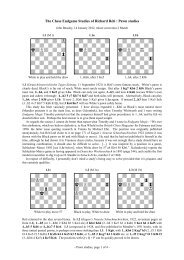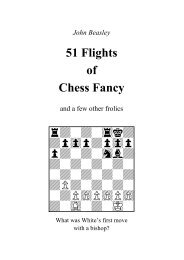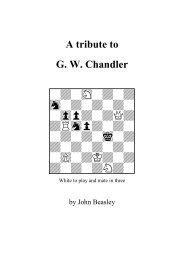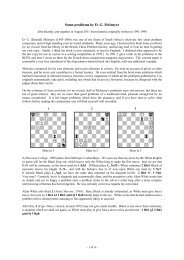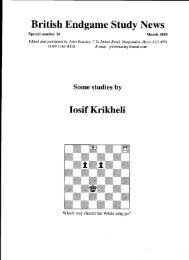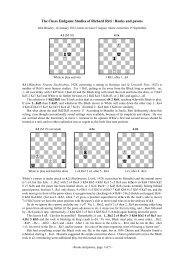THE THEORY OF CHESS PROBLEMS - John and Sue Beasley
THE THEORY OF CHESS PROBLEMS - John and Sue Beasley
THE THEORY OF CHESS PROBLEMS - John and Sue Beasley
- No tags were found...
Create successful ePaper yourself
Turn your PDF publications into a flip-book with our unique Google optimized e-Paper software.
assumed game to have featured either a good opening or first-class play. Such requirements might producepositions which would be wholly plausible, but from an artistic point of view very unattractive.The position should also be such as to give no clue to the solution. The men should have a wide choice ofmoves, both in attack <strong>and</strong> in defence. The White men should not be placed at a distance from the battlefield, inpositions where they are clearly useless <strong>and</strong> from which they must be advanced as quickly as possible. A positionis unsatisfactory if the final mating configurations are largely in place at the outset. A particular give-away to theplace of execution is a group of Black men conspicuously placed, <strong>and</strong> White pawns also frequently betray it.A large number of White pawns is never conducive to a beautiful position, either from this point of view or fromthat of the strict requirements of economy.(i) Threat <strong>and</strong> waiting playD. Artistic considerations affecting constuctionIn a game, there are two ways in which the result can be decided. Either the attacking side makes a threat of somekind, <strong>and</strong> the defender, forced to cover this threat, allows some other winning continuation in its place, or theresult is decided by zugzwang: the defender, compelled to move by the rules of the game, has to make a choicebetween weakening moves, <strong>and</strong> these either gradually erode his position or cause his immediate collapse. Ingeneral, wins by threat occur in the middle game, <strong>and</strong> by zugzwang in the endgame.So it is with the problem. The first move may be a direct threat, to which Black has various defences some ofwhich lead to the thematic variations. Alternatively, it may be a waiting move. Here, there is no question ofdefence against a threat, because no threat exists; if the defending side were not forced to move, the attackercould not give mate within the number of moves dem<strong>and</strong>ed. However, the rules of the game do compel thedefender to move, <strong>and</strong> each of his possible moves allows a winning reply.The construction of a problem, be it a threat or a waiting problem, is palpably an important criterion in thejudgement of its value; it is the skeleton on which the problem is built. A threat exerts direct pressure, more orless strong, whereas a waiting move eschews such direct pressure <strong>and</strong> offers something quite different, the delicatecontrol of the complete opposing force. The general principle of refinement of play naturally favours gentlethreats <strong>and</strong> waiting play, <strong>and</strong> deprecates multiple strong threats.A single-move threat, where the key threatens immediate mate, is not something we can commend, but itwould be wrong to disdain it entirely. There are themes which cannot be realized without such a threat. Such athreat is of course a defect, but it is justified until such time as a better setting is shown to be possible. However,when we do need recourse to such a threat, it should be met by a large number of moves, so that neither thekeymove nor the threat itself is unduly obvious.A threat should be as long as the stipulation allows, so a three-mover should feature a two-move threat <strong>and</strong> afour-mover a three-move threat, although in the latter case a two-move threat is also acceptable. It should also beas gentle as possible; a quiet threat is always better than one which proceeds by checks.It may happen that the first move of a problem creates more than one threat. Although we do not stigmatizethis as an irrevocable defect, in the case of the simpler problems, particularly three-movers, it is best eliminated asfar as possible. But complicated more-movers can often be realized only by the use of multiple threats. We assessthe construction according to the strongest threat, <strong>and</strong> the remaining threats usually become part of the variationplay. More rarely, the threat also forms the mainplay. In a problem where several variations are effectively equalin importance, the matter is neither here nor there, but otherwise it is usually best for the mainplay to follow adefensive move rather than to be threatened. And further on in the solution there may be subvariations, whichmay result either from threat or from waiting play.All this reduces to the principle that a long, quiet, gentle threat is to be preferred to one which is short,checking, <strong>and</strong> strong. Waiting play is clearly better still, always provided that the position is not such as to makethe need for a waiting move obvious to the solver.The construction of a problem gives a clear measure of a composer's technique, though naturally only to theextent that he attaches importance to the matter. A problem in which an excellently contrived attacking force isharmoniously united with ingenious use of the defensive force has always the stamp of a masterwork. Suchconstruction in depth can compensate for mediocre content, or, when combined with beauty <strong>and</strong> variety of content,can create a true masterpiece. But just as it is a mistake to underestimate the value of construction, so it is anequal mistake to overestimate it. Sometimes composers forget the importance of the content of a problem, <strong>and</strong>devote all their attention to its form. Just as we do not like to see a beautiful idea in mean clothes, so do we dislikethe opposite. Excellence of construction is not to be sought at the expense of other artistic principles. In particular,waiting play is often attainable only at a cost in other directions. The majority of problem themes, particularly themore complicated themes, cannot be shown in waiting form; but where waiting play does not betray itself by thevarious signs which are obvious to the eye of the expert, we have that very rare thing, the work of a master.Better, however, is a work which is harmonious in all respects than one which is perfect in one respect butbanal <strong>and</strong> aesthetically unsatisfactory in another.l0-



